
The need for digital transformation is considered an important task for all businesses, big and small. Businesses must learn to be competitive and relevant in this new ecosystem as the world grows more digital. Nowadays, one of the most used buzzwords is "digital transformation." But many corporate executives are still unclear about what the term "Digital Transformation" means. How should I approach accomplishing it? What are the steps in the transformation process to be taken? Is the effort worthwhile?
This blog aims to address some of the most often asked questions regarding digital transformation, emphasising top digital transformation trends in manufacturing, issues, and advantages of digital transformation in manufacturing.

Breaking the Myth
In the process of how quickly technology is evolving, there are several detrimental and misleading assumptions about how digital transformation fits into an organization's broader vision.
Myth 1: Small and medium-sized firms cannot undergo a digital transformation; it only applies to huge enterprises.
There is a mistake in thinking that small and medium-sized enterprises are not candidates for digital transformation. Of course, depending on the company's size, the level of application and adoption may vary, but failing to adopt digital technology is a definite way to become extinct.
Myth 2: Digital serves as a support function to increase gains slightly.
Many businesses are switching from only considering technology as a support function to seeing it as a source of income. Businesses that have successfully incorporated digital technologies into their operations have boosted productivity, diversified their sources of income, competed with digital natives, and outperformed rivals.
If you want to know more about such myths, you can contact our assignment provider for further help.
Digital Transformation Trends in Manufacturing
This year consistently follows the trends set up as an objective in the last few years. The changes lie not only in the technology employed but in a growing number of organizations going into the digital mode.
Let's shed light on the digital transformation trends in 2022.
Machine Learning and AI
AI or Artificial intelligence incorporates the production of intelligent hardware or software, which can analyze human behavior, including problem-solving and learning.
IoT (Internet of Things)
It is the network of several physical objects merged with software. Also, it comprises a network of interconnected electronic devices and sensors that collect and exchange data.
5G and Smart Manufacturing
In the last few years, one can see that 5G has been a trending topic in the market, especially when 5G entered the world of manufacturing.
3D Printing Technology
You must have heard about 3D printing; the use of this technology assists organizations m making faster and more affordable prototypes. This innovation assists in better performance and more productivity.
Next Generation Manufacturing Employees
It comprises workforce skills; it is evident that with the technological advancement covering repetitive work, multiple conventional manufacturing jobs will phase out. Moreover, with an increase in supply chain demand, organizations are automating functions to increase productivity. Learn about these trends in detail and connect with our experts at instant assignment help.
Challenges of Digital Transformation in Manufacturing
Let's take a look at several challenges of digital transformation in manufacturing.
Speaking Of Digital Transformation, There Is Resistance To Change
In the past, each stage of the manufacturing process ran independently, without being aware of adjustments made at earlier phases. Organizations had to deal with various issues due to the absence of integration, including high inventory, lost productivity, and wasted resources.
Capital Initial Investment
Small and medium-sized businesses may lack the funding necessary to adopt new technologies or invest in them. This can be a hurdle when businesses want to transition to the digital age, but manufacturers need to learn to look at the wider picture.
Lack of expertise and knowledge in digital transformation
The inability to use new manufacturing technology safely and securely is one of the main problems with factory digitization. Manufacturers must make an effort to understand how to apply big data analysis, Machine learning, digital twins, and automation as they develop their advanced technological capabilities. If not, progress may be slowed by a lack of understanding in these and other areas.
Security Issues With the Digital Revolution
Bigger equipment is connected via IoT as digitalization becomes a worldwide trend and a gauge of growth. Robotics, AI, and autonomous robots are gradually replacing human labor by taking over administrative chores, frequently unsupervised. Due to the volume of data generated by all of this, maintaining the security of all personal and professional data has proven to be difficult and a source of significant concern for many years.
Benefits of Digital Transformation in Manufacturing
Organizations that invest in digital transformation get huge rewards. Transformation is essential if an organization is to stay viable and competitive because it has economic and commercial advantages as well as environmental and social ones.
Improved output quality
Manufacturers can produce better-quality products with more sensors, automated testing, and quality control throughout the manufacturing process. Manufacturers can adjust any manufacturing line to lower errors and enhance procedures using the Pareto principle (and knowledge obtained from machine learning).
Enhanced Process Efficiencies
Organizations can eliminate human error from their manufacturing processes through hyper-automation. Hyperautomation is the integration of machine learning (ML) and artificial intelligence (AI) to support human work.
Green Thinking
As consumers' demands for eco-friendly activities grow, technology advances to supply solutions. Machines that AI controls are more efficient and use less energy. Increasing efficiency frequently encourages less material consumption as well.
Lower Costs, Higher Margins
Costs for manufacturers are reduced by digital transformation. With the help of the Internet of Things (IoT), manufacturers can more quickly identify and fix problems. Manufacturers can gain from connected machinery's range of advantages, including the ability to diagnose issues before they develop and schedule maintenance for increases in output.
Flexibility
In business, flexibility is the solution to stand in a competitive market and situations. When operations are flexible, adaptability is important for
While operations are resilient, adaptability is crucial for long-term success. Manufacturers must be able to anticipate and respond to challenges to stay ahead of the competition.
Digital technologies help manufacturers by harnessing flexible automation, operating remotely, and connecting the supply chain with cloud-based infrastructure. If you are pursuing a course related to digitalization and facing any issues with the assignment, then you can connect with our experts at Assignment Help Australia.









Loved reading this Blog? Share your valuable thoughts in the comment section.
Add comment